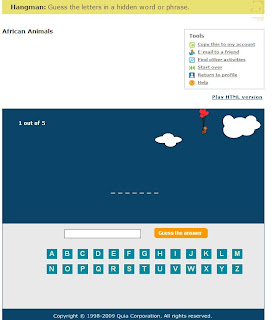THE LEARNING FEDERATION
Having registered with the Learning Federation I was able this week to look over the amazing educational multimedia resources the Federation is able to offer teachers and students. This website offers resources on nearly every curriculum area that is covered from P-12. It offers links to museums, war memorials, National Archives of Australia and art galleries, to name just a few. Nearly anything you can think of is on this website! This tool will be so useful next year when I start my teaching career. There's information on any topic and you can just follow the links to find out about specific areas such as archeology, art, mathematics, social sciences, etc. It will be great to have a resource to go to if there's something in curriculum that I don't know much about and I log onto this website and not only find out about the topic but be given a multimedia resource to teach the topic to my class. It also offers assessment of students work online so teacher's are not burdened with never ending amounts of marking. So the students can go online, learn about a topic, do the activities and be graded by the program. I think teachers can use all the help they can get!!
EXCEL
 M&M spreadsheet
M&M spreadsheetIn this week's workshop, we grouped the colours of a packet of m&m's and counted how many in each group. We then put them into an excel spreadsheet. I really like excel, I'm not sure why. Maybe because it's really organised...? There are so many wonderful things you can do on excel, not only for maths. While maths is the obvious one with entering data and creating spreadsheets, literacy, ICT and other skills can be used also. Excel can be used to create surveys and analyse the data (literacy and possibly numeracy), create timelines (literacy) and create graphs or pictographs (literacy and numeracy).
There are many other online programs that allow you to create spreadsheets and graphs such as MathGV which allows you create polar graphs, cartesian graphs and dimensional graphs. You can even create artistic graphs that look amazing! Smart Draw offers the same graph building software but also includes mindmaps, timelines, flowcharts and organisation charts, plus much more. There are endless amounts of software out there that can be used successfully in the classroom. I haven't had the experience of seeing students using this type of product on placement yet but I believe it would be quite valuable for older students. These programs are also great time savers as students can spend ages just drawing up the graphs but if the template is there already for them to use, they just add the data and they're away!
This week's Dust Echoes activity showed me a great way of testing students comprehension without having to give them boring questions to answer in their literacy books. I am always struggling with new ways of testing students comprehension so that they don't get bored and neither do I! This idea would work with many different programs including concept mapping, mind mapping or even just Word. Kidspiration is another great online resource. It's similar to Inspiration except that it's designed for students up to grade 5. Students can develop their literacy, numeracy, ICT and art skills with this program. It also strengthens students thinking skills by allowing them to create mind and concept maps.
Another way the fantastic Dust Echoes dreamtime stories can be used is to get students to create their own animations based on the particular topic they might be studying at the time. Online software such as FluxTime Studio or Toon Boom Animation allow students to create their own animations and share them with others. Students will love creating their own animations and will be developing their literacy, ICT, thinking and art skills while they do so!






